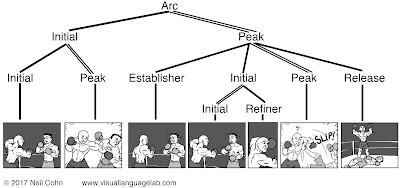New paper: Drawing the Line…in Visual Narratives
I’m happy to announce that we have a new paper in the latest issue of the Journal of Experimental Psychology: Learning, Memory, and Cognition entitled “Drawing the Line Between Constituent Structure and Coherence Relations in Visual Narratives.”
This was my final project at project at Tufts University, and was carried out by my former assistant (and co-author) Patrick Bender, who is now in graduate school at USC.
We wanted to examine the relationship between meaningful panel-to-panel relationships (“panel transitions”) and the hierarchic constructs of my theory of narrative grammar. Many discourse theories have posited that people do assess meaningful relations between each image in a visual sequence, and (like in my theory) people make groupings. Yet, in these theories, the groupings are signaled by major changes in meaning, such as a “transition” with a big character change. We hypothesized that groupings were not actually motivated by changes in meaning, but by narrative category information that align with larger narrative structures.
So, we simply gave people various visual sequences and asked them to “draw a line” between panels that would best divide the sequence into two meaningful parts—i.e., to break up the sequence into groupings. People then continued to draw lines until all panels had lines between them, and we looked at what influenced their groupings. Similar tasks have been used in many studies of discourse and event cognition.
We found that panel transitions did indeed influence their segmentation of the sequences. However, narrative category information was a far greater predictor of where they divided sequences than these meaningful transitions between panels. That is: narrative structure better predicts how people intuit groupings in visual sequences than semantic “panel transitions.”
The paper is downloadable here (pdf) or along with all of my other papers.
Full abstract:
Theories of visual narrative understanding have often focused on the changes in meaning across a sequence, like shifts in characters, spatial location, and causation, as cues for breaks in the structure of a discourse. In contrast, the theory of visual narrative grammar posits that hierarchic “grammatical” structures operate at the discourse level using categorical roles for images, which may or may not co-occur with shifts in coherence. We therefore examined the relationship between narrative structure and coherence shifts in the segmentation of visual narrative sequences using a “segmentation task” where participants drew lines between images in order to divide them into subepisodes. We used regressions to analyze the influence of the expected constituent structure boundary, narrative categories, and semantic coherence relationships on the segmentation of visual narrative sequences. Narrative categories were a stronger predictor of segmentation than linear coherence relationships between panels, though both influenced participants’ divisions. Altogether, these results support the theory that meaningful sequential images use a narrative grammar that extends above and beyond linear semantic shifts between discourse units.
Full Reference:
Cohn, Neil and Patrick Bender. 2017. Drawing the line between constituent structure and coherence relations in visual narratives. Journal of Experimental Psychology: Learning, Memory, and Cognition. 43(2): 289-301.

Comments